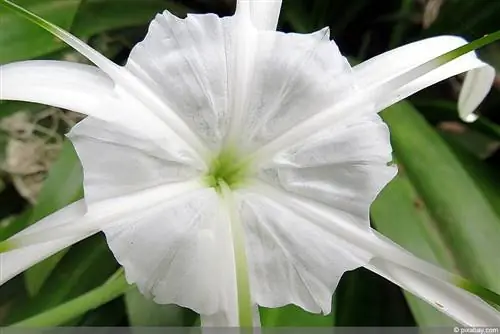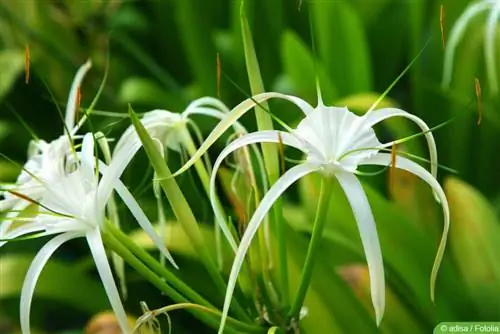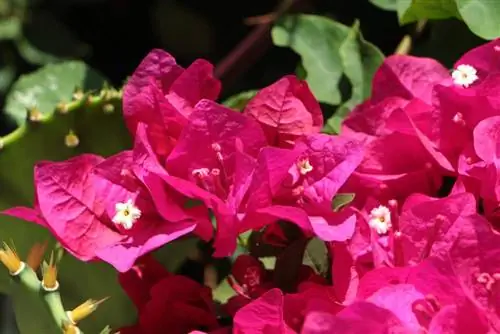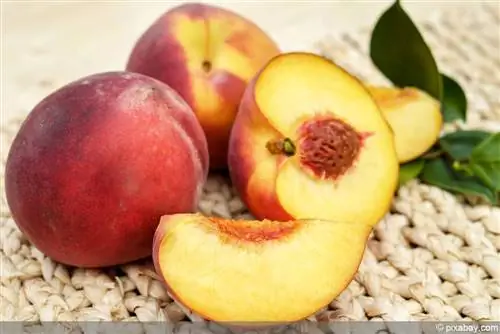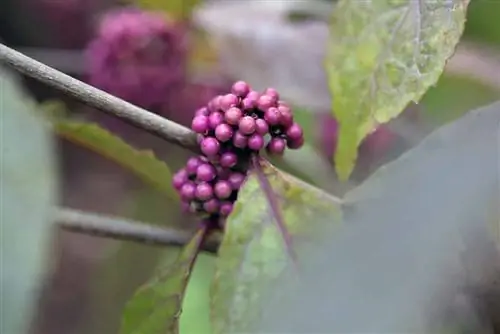- Author admin [email protected].
- Public 2023-12-17 03:39.
- Last modified 2025-01-24 12:45.
Ismene, originally from South America, is a bulbous flower with an extraordinary look. From June/July to August, a single bulb produces several flower stalks, each with two to five flowers. The delicate, very narrow, outwardly rolling and slightly curled petals are particularly impressive. It is precisely these flowers that make this easy-care plant an eye-catcher in the garden, on the balcony and on the terrace.
Location requirements
The Ismene festalis, also known as the beautiful skin or Peruvian lily, loves warm, wind-protected, sunny to full sun locations, preferably with afternoon sun. The fleshy leaves in particular could react sensitively to the blazing midday sun. A place outside in front of a warming house wall is ideal. The location for houseplants should be free from drafts and cold winds and at least partially sunny. A spot near a south-facing window is ideal here. If necessary, provide light shade for a short time to protect against the blazing midday sun. In darker rooms, additional light sources, e.g. in the form of daylight lamps, are recommended.
Ismene does not need any special soil. It can cope with any good garden soil that is loose and well-drained, moderately fertile and not too wet. High-quality potting soil or a sand-clay mixture is suitable for pot planting. Excess water should be able to drain off easily at all times and waterlogging should be avoided at all costs.
Plants
The best time to plant Ismene festalis is in spring, from mid-May. As soon as the outside temperatures no longer fall below 15 degrees, you can plant.
- Prefer potted plants indoors from March
- Out into the open after the Ice Saints
- To protect against voles, insert wire mesh before planting
- Place onions eight to ten centimeters deep in the ground
- Planting depth depends on bulb size
- Onion neck should be about halfway out of the ground
- Keep planting distances of 15 to 20 cm
- Count around 16 onions per square meter
- Water the bulbs after planting
When planting in a container, ensure appropriate drainage. In the right location and with appropriate care, the first flowers appear about four to five weeks after planting.
Tip:
Due to the lack of winter hardiness, it is advisable to always cultivate Ismenen in pots. This also saves digging up in the fall.
Care
This clump-forming summer flowering plant fascinates with its impressive flowers and growth heights between 50 and 80 cm. The strap-shaped, dark green, shiny leaves appear first and in summer the delicate flowers appear, several of which sit on the 40-60 cm long flower stalks. Beautiful skins come into their own just as well when planted alone as in group plantings or in combination with other flowering plants. Even if they can be classified as easy to care for, they cannot do without care.
Pouring
A little sensitivity is required when it comes to water requirements. The soil should be neither too wet nor too dry, although a briefly drier substrate is better tolerated than too much moisture. During growth, from April/May to September/October, the soil should be slightly moist. As soon as the first shoots appear, water regularly. Later, when the inflorescences form, the watering amounts are increased slightly. The soil can dry out on the surface, but should not dry out. If there is drought during flowering, the Ismene drops its flower buds. In the fall, watering is gradually reduced until the leaves are covered in fine skin.
Fertilize
A commercially available liquid fertilizer or flower fertilizer should be administered weekly six weeks after planting at the earliest. Potted plants that have been recently repotted usually do not need any additional fertilizer this year. This is because potting soil is pre-fertilized so that the plants are well supplied with nutrients for a certain period of time. Later you can fertilize in spring with a slow-release fertilizer in the form of granules or sticks or monthly from April to August with a liquid fertilizer.
Wintering
Ismene festalis is not hardy in this country and requires a rest period of three to six months. Overwintering outdoors is not recommended, even in mild locations.
- Reduce watering in autumn
- Get onions in the bucket before the first frost
- Dig up onions in the bed after the plant has wilted
- Cut off wilted leaves and stems and remove the onion from the ground
- Leave brood or daughter onions attached to the mother onion
- After digging up the onions, let them dry
- Then carefully remove loose soil
- Leave stuck soil residues on the bulb to avoid root damage
- Root damage can affect next year's flowers
- Store loose onions lying in wood shavings, newspaper or wood litter
- Wintering dark, cool, dry, draft-free but still well ventilated
- Ideally at temperatures between 8 and 10 degrees
In April, the bulbs can be repotted into fresh substrate and placed a little warmer, at 16-18 degrees. Shorten the roots minimally when repotting. The pots can be taken outside again and specimens can be planted in the bed from mid-May at the earliest. From now on there will be a little more watering.
Tip:
Don't dig up the onions until the leaves and stems are completely wilted. As long as the leaves are still green, the onion extracts all the nutrients it urgently needs for overwintering.
Propagate
Through breeding onions
Propagation takes place mainly via brood or daughter onions, which usually form several times on the mother onion. The onions should have reached a certain size before they are separated. The roots of Ismene do not like disturbances of any kind. That's why you should only split the onions if it's absolutely necessary.
- Be very careful when dividing the onions
- Roots can be easily damaged or torn off
- Best time to share is in the fall after digging
- Divide onions that have overwintered in pots when repotting in spring
- Grow bulbs from April in a bright place in the house or greenhouse
- Beautiful skin should go outdoors in mid-May at the earliest
- There should be no risk of night or late frosts
Tip:
The roots should not be damaged when dividing the bulbs or planting them. Within two to three years, new flowering ismenes form from the daughter bulbs.
Through seeds
Propagation via seeds is much more complex than via seed bulbs and is not always successful. Furthermore, little is known about whether young plants actually arise from this and whether they are even capable of reproduction. With a bit of luck, these plants produce so-called capsule fruits with large, green, fleshy seeds, provided pollination occurs and ovaries are formed.
This is rarely the case with hybrids. The seeds can be sown in growing substrate from April and grown indoors. If seedlings actually develop, it may make sense to cultivate them permanently in the pot after separating them or repotting them in a suitable substrate. This also makes it easier to transport to winter quarters later. Of course you can also plant them outdoors in a sunny spot from mid to late May.
Diseases
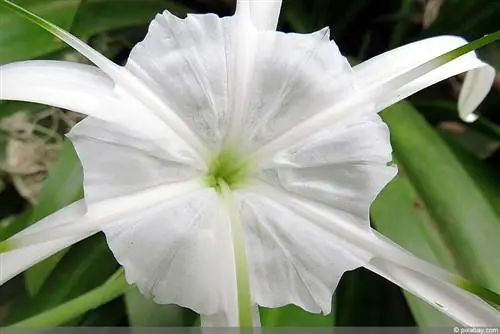
Illnesses rarely occur in Ismene festalis. Only if watering is too frequent or intensive is there a risk of rot, which is usually fatal for the onion. Onions that have already been damaged by too much moisture can usually no longer be saved. This makes it all the more important to ensure a water supply that meets your needs and ensures good water drainage.
Pests
Voles
- The greatest danger to the onions comes from voles and other rodents
- They're only after the onions
- To protect it, it is best to place the onion and the pot in the ground
- Plastic pots are unsuitable
- Natural materials such as unglazed clay are optimal
- Or lay out close-meshed wire mesh before planting
- Wire mesh should not be too large mesh
- Commercial rabbit wire is very suitable
- For laying, first dig out a sufficiently large hole in the earth
- Depth and width of the pit depends on the number and size of the bulbs
Lay the wire mesh into the prepared earthen trough so that both the floor and the walls of the trough are lined with it. Then cover the grid with some soil, insert the bulbs and fill with soil.
Aphids
Aphid infestation can also occur in some cases, especially along the stems. To combat this, affected plants can be sprayed several times with stinging nettle broth until the infestation is no longer detectable. The use of natural predators such as ladybirds and lacewings has also proven successful in many cases.
Daffodil fly
The daffodil fly, which hollows out the flower bulbs and then lays its eggs there, can also cause problems. If an infestation is detected early, the larvae can be killed by placing the onion in a 42-43 degree water bath for two hours. In order to protect the onion from renewed infestation, it should under no circumstances be planted in the same place in the garden or in the same substrate. If the old pot is to be reused for potted plants, it must first be thoroughly cleaned and, ideally, disinfected. As a further preventive measure, dead onions should not be disposed of in the compost.
Bringing Ismenes to bloom
The fragrant and shapely flowers of Ismene are a real eye-catcher. He althy plants bloom year after year. However, it can happen that plants do not want to bloom properly or they lose flowers.
- If flowers fall off, dryness is usually the cause
- It's best to water regularly but not excessively
- Soil should not be waterlogged or dried out at any time
- If the flowers don't bloom or are very sparse, a location that is too shady may be the cause
- Plant then uses a lot of energy to form a lot of leaf mass
- Flower formation is neglected
- So always pay attention to a sunny location
- After the bulbs are divided, the flowering usually stops in the first few years
- It can take two to three years for the first flowering
- Beautiful people don't want to stand too close either
- They should not be harassed in growth
- Accordingly, make sure there are sufficiently large planting distances
It can also partly be due to fertilization if the flowers are poor. Even though compost is an all-rounder when it comes to fertilization, it is less suitable for these plants. This is because its actual nutrient content is difficult to estimate. It can happen that plants suffer from a nutrient deficiency. Mineral fertilizers, which contribute particularly to increased foliage development and less to flower formation, are also rather unsuitable. Commercially available liquid fertilizers are more recommended.

